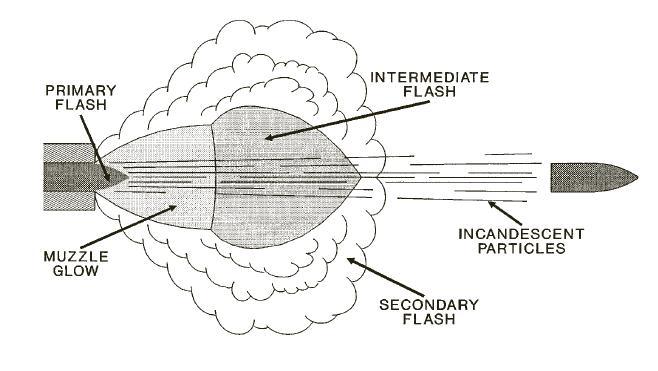Rather than over-extend the previous thread by continuing this concept here where we don't interfere with the original poster's needs.
I want to add a couple of thoughts regarding the 'test' in the videos:
- The type and chemical composition of the powder used in any particular load will have a definite effect on the muzzle flash. Your choice of H-50BMG is the newest version of Hodgdon's Extreme powders which use a flash suppressant or deterrent, if you rather to control the volume of the muzzle flash. Other powder formulations lack this coating or compound which creates more plasma, which appears as a larger muzzle flash.
I happened to shoot my J-Frame at night with some of the .38 Special +P ammo that I carry and it was like a sun-spot had erupted. My night vision was destroyed. Luckily I was just at the range, not fighting for my life. Bryce M. Towsley
Same revolver, different ammunition...
- Muzzle brakes, like your 12-port and 10-port used on the firearms in your video, redistribute the hot gases (plasma) which makes up the muzzle flash, at right angles to the muzzle rather than allowing it to escape in volume directly out of the muzzle in front of the shooter. In essence the brake's ports dilute the effect from what it could be without the brake.
History and Technology
Muzzle Flash
By Tony DiGiulian
from NAVWEAPS -
http://www.navweaps.com/index_tech/tech-090.php
Five Kinds of Flash. Image from "Combat Systems I: Sensors" by Dr. Robert Harney of the
Naval Post Graduate School.
When a gun fires, only about 30% of the chemical energy released from the propellant is converted into the useful kinetic energy of actually moving the projectile down the barrel. The remaining energy is primarily contained in the propellant gas-particle mixture that escapes from the muzzle of the gun in the few milliseconds before and after shot ejection. A significant portion of this remaining energy is dissipated in the bright "muzzle flash" seen when the gun fires.
This flash consists of at least the following five components:
Muzzle Glow
Muzzle Glow is usually a reddish white glow or tongue of flame at the muzzle that appears just prior to shot ejection and persists after shot ejection until the chamber pressure drops significantly. The initial glow is usually the result of hot, highly compressed gases (unburned propellants) leaking past the projectile driving band and is brightest in a worn gun. These gasses are hot enough to emit radiation in the visible light band. A "Cold Gun" with its lubricated barrel generally shows less muzzle glow than does a "Hot Gun" with its expanded barrel.
Primary Flash
Primary Flash occurs after the projectile has exited the muzzle and is caused by those propellant gases exiting the muzzle behind the projectile. These are hot enough to emit large amounts of visible radiation but cool rapidly as they expand away from the muzzle.
Intermediate Flash
Intermediate Flash consists of a reddish disc, slightly dished towards the gun, which appears about three inches (7.5 cm) from the muzzle of a small-caliber weapon and about 20-25 calibers from the muzzle for larger caliber weapons. Intermediate Flash occurs at the time of shot ejection and persists until the chamber pressure drops. It is brightest at the edge nearest the gun and gradually fades as the distance from the muzzle increases. This flash is due to a Mach shock wave created by the escaping gasses and projectile which, with its attendant pressure rise, causes the propellant gases to attain a temperature almost equal to the chamber temperature and so become self-luminescent.
Secondary Flash
Secondary Flash appears beyond the zone of the intermediate flash and is a rather ragged vortex of yellowish white flame. This is a result of the ignition of the combustible mixture of propellant gases and atmospheric oxygen caused by the turbulent mixing occurring at the boundary of the gas jet as it leaves the muzzle. The ignition of this mixture would appear to be initiated by its exposure to the high temperature of the intermediate flash.
Sparks
Sparks are a common feature of the flash for small arms. These can arise from the ejection of incompletely burnt powder particles or by the ejection of white-hot acid or metallic particles. The former can be crystals of potassium salts if the powder is a "flashless" one while the latter can be the residual fragments of the metallic components of the cap composition or fragments of burning metal from the bullet jacket or driving bands.
Of these five components, the intermediate and secondary flash are the greatest contributors to muzzle flash. Most of the radiated energy occurs during the secondary flash and this can be greatly reduced by attaching a flash reducing device to the gun muzzle. These are commonly known as "Flash Suppressors" and appear on many military-style small arms and automatic weapons. These attachments act by modifying the gas glow pattern such that there is no region or a greatly reduced region in which the inflammable mixture of air and muzzle gases is sufficiently hot enough to ignite. It should be realized that there are other kinds of Flash Suppressors which do not modify the gas flow patterns in this manner but instead work by directing part of the muzzle gasses away from the shooter. These kinds of Flash Suppressors and the simpler "Flash Hider" muzzle attachments are intended primarily to reduce or block the muzzle flash from the vision of the shooter in order to maintain his night vision, they do little to reduce the size of the flash itself.
___________________________________________________________________
The above is just some additional reading from one of our military "think groups".
Enjoy!




